Dragonflies -The Hawks of the Insect World Are Important Environmental Indicators
Dragonflies are an ancient family of insects. They have been around for 300 million years — predating even the dinosaurs. Some ancient dragonflies had a wingspan of more than 2 feet. Today, there are more than 5,000
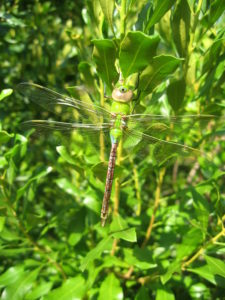
Common Green Darners (Anax Junius) are known to migrate up to 85 miles a day. Note the large eyes on the head, the wings at rest to its side and its segmented abdomen –all traits of dragonflies. Migratory dragonflies are environmental indicators of their breeding habitat, migratory habitat and overwintering habitat. Photo courtesy of Chris Pupke.
different species of dragonflies and they can be found on every continent except Antarctica. Conserving dragonflies and their habitat must be a priority because they are valuable environmental indicators. Biophilia Foundation is proud of its partners’ work to restore and protect dragonfly habitat.
Description, Life Cycle and Diet:
Dragonflies are members of the order Odonata. Each dragonfly has six legs, four wings, a head, thorax and abdomen. The abdomen is divided into ten segments. Their eyes are compound –they consist of 24,000 ommatidia (or tiny eyes). Many dragonflies are beautifully colored with greens, reds, yellows and blues.
A dragonfly’s life cycle is an example of incomplete metamorphosis. Eggs are laid in or near water. Nymphs hatch from the eggs. Dragonflies spend most of their life as a nymph where they molt anywhere from six to fifteen times. Eventually, the nymph will shed its final exoskeleton and an adult will emerge, leave the water, and fly away. Water pollution has negative impacts on dragonflies due to their reliance on aquatic ecosystems throughout their life, making dragonflies important environmental indicators of water quality.
Dragonflies are not picky eaters — they will eat whatever is available. Often, but not exclusively, their diet consists of insects. Nymphs also consume freshwater invertebrates, tadpoles, and even small fish. Adult dragonflies capture their insect prey in flight, taking advantage of their extraordinary vision and flight ability — giving them their nom-de-guerre: “The Hawks of the Insect World”. The widespread use of broad spectrum insecticides eliminates food sources for dragonflies. When dragonfly populations decrease, it can be an environmental indicator that there is a problem in the food chain.
Flight:
Dragonflies possess remarkable flying skills. They can fly forward at approximately 35 miles per hour. They can even hover in mid-flight for almost one minute and rotate 360 degrees in place. Moreover, they can fly backwards with similar alacrity.
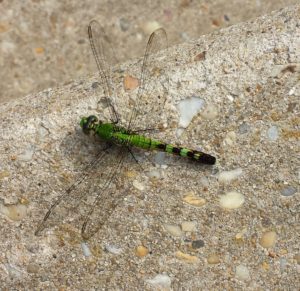
Dragonflies, like this female Eastern Pondhawk (Erythemis simplicicollis), consume insects and invertebrates making them a critical link in the food chain. Eastern Pondhawks in particular are known to consume large numbers of agricultural pests. Dragonflies are cold blooded –this pondhawk is warming itself in the sun on a stoop. Photo courtesy of Chris Pupke.
To learn more about dragonflies flying skills, see this video report from Science Magazine about dragonfly’s ability to fly backwards: http://www.sciencemag.org/news/2018/07/video-reveals-secret-dragonfly-s-backward-flight
Some dragonflies utilize their flying skills to migrate. In North America, there are 16 species of dragonflies that are known to migrate. The Common Green Darner, for example, can migrate at up to 85 miles per day. Some dragonflies have been reported to migrate across the Gulf of Mexico. Conversely, three dragonflies were documented circling back north from Cape May, NJ to cross the Delaware Bay at a narrower location. Migratory dragonfly populations indicate environment health in both their breeding habitat, migratory habitat and overwinter habitat.
The dragonfly’s remarkable flight ability stands in contrast to its cousin, the damselfly, who tends to be a less accomplished acrobat.
Read Also: Nesting Boxes — Nests, Eggs, Chicks and Surprises
Dragonflies Are Not Damselflies:
Within the order of Odonata, there are two suborders — dragonflies and damselflies. The two suborders are often just called dragonflies but there are important differences that make damselflies distinct. Perhaps the most obvious difference is the way their wings lay when at rest –a dragonfly’s wings will be held separately down at their side while a damselfly will hold its wings together over their back.
Other differences include the body shape (dragonflies have thicker bodies than the slender damselflies) and their eyes (damselflies have two distinct eyes while the eyes of dragonflies typically almost meet in the middle of their head).
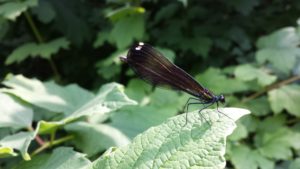
The Ebony Jewelwing (Calopteryx maculata) is a damselfly, not a dragonfly. Here one can see the wings rest over the back (as is typical of damselflies but not dragonflies). The body is more slender than a dragonfly. The white tips on the end of the wings help identify this individual as a female. Photo courtesy of Chris Pupke.
Damselflies are about 250 million old — a mere 50 million years younger than dragonflies! There are 2,942 known species of damselflies. Damselflies, however, are better adapted to cooler temperatures than dragonflies. Both species require healthy environments to thrive and serve as environmental indicators of both healthy and unhealthy ecosystems.
Dragonflies In Culture:
Humans have long taken notice of dragonflies. Unfortunately, in Western Europe most of this attention was negative. A quick look at nicknames of dragonflies from Europe shows their lack of respect (the Devil’s Darning Needle, ear cutter, and horse stinger for example.)
However, other cultures hold the dragonfly in higher esteem. In Japan, dragonflies have been highly regarded for millennia. One story recounts how Emperor Jimmu, the legendary first emperor of Japan, was bitten by a mosquito. Subsequently, a dragonfly ate the mosquito and forever earned the respect of the emperor. The Samurai eventually adopted the dragonfly as a symbol of power, agility, and victory.
Dragonflies appear in many different art forms including pottery, stained glass, jewelry, and art. They are particularly popular in Art Nouveau works.
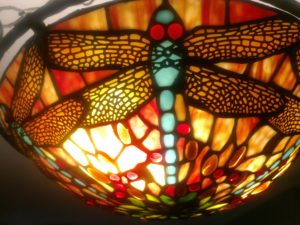
Dragonflies appear in many different forms of art, including stained glass lamp shades. Photo courtesy of Chris Pupke.
Dragonfly Conservation:
Dragonflies are an important environmental indicator. They rely on healthy aquatic ecosystems and healthy food chains. Threats to their wellbeing include habitat loss and water pollution. The International Union for Conservation of Nature calls for modifying agriculture, forestry, and industrial procedures to help conserve habitat. After noting their myriad values, Norman W. Moore states in the IUCN’s report “Dragonflies: Status Survey and Conservation Action Plan”:
“We must conclude that dragonflies are valuable, and that they are threatened throughout the world through habitat loss and pollution. Therefore action to conserve dragonflies is urgent. A wide range of measures is required.” (Moore p. 6)
Moore notes that Great Britain lost three species of dragonflies between 1950 and 1995. He declares that dragonflies have inherent value as a life form on the planet, as a source of genetic diversity, as ambassadors to the insect world, as bio-indicators for environmental health, and for their consumption of insects that are harmful to humans.
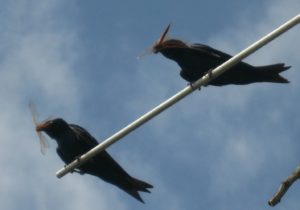
These Purple Martins are feasting on dragonflies and demonstrating the critical link dragonflies provide in the food chain. Dragonflies occupy an important place in our ecological community and their conservation must be a priority. Photo courtesy of Chris Pupke.
How Biophilia Foundation Supports Dragonflies:
By promoting conservation of wildlife habitat and the restoration of wildlife habitat, Biophilia Foundation helps conserve dragonflies and preserve this critical environmental indicator.
Our partners at Borderlands Restoration Network (BRN) help restore dragonfly habitat every time they install a gabion in an eroded stream bed in the arid southwest. These gabions help retain water, thereby restoring habitat suitable for dragonflies.
The restoration of wetlands in the Chesapeake Bay region also provides enormous benefits for dragonflies. When our partner Chesapeake Wildlife Heritage (CWH) restores a farm field back to a wetland, dragonfly habitat increases. In fact, dragonfly research at one wetland CWH restored found 19 different species of dragonflies in just two hours!
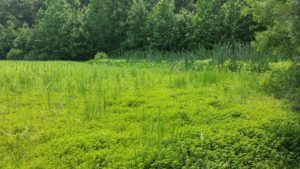
Nineteen different species of dragonflies were identified in this wetland near the Choptank River on the Eastern Shore of Maryland. Chesapeake Wildlife Heritage restored the wetland from a farm field. The preservation and restoration of dragonfly habitat is critical if we are to preserve dragonfly populations. Photo courtesy of Chris Pupke.
You can help dragonflies by supporting BRN, CWH, or a group in your area that restores wildlife habitat. If you own land, reach out to one of our partners to learn how you can make a difference for dragonflies — like all our wildlife, they are counting on us.
Related Blog: Wildlife Friendly Fencing by Chris Pupke
Sources:
Dunkle, Sidney W.; Dragonflies Through Binoculars: A Field Guide To Dragonflies Of North America; Oxford University Press; 2000.
May, Michael L.; “A Critical Overview of Progress in Studies of Migration in Dragonflies”; Published online with open access provided by Springerlink.com; November 2012.
Moore, Norman W. (Compiler); “Dragonflies: Status Survey and Conservation Action Plan”; International Union for Conservation of Nature; Gland, Switzerland; 1997.
http://azdragonfly.org/welcome
http://dnr.maryland.gov/wildlife/Pages/plants_wildlife/mdodonates.aspx
http://scalar.usc.edu/works/chid490animalmourning/dragonfly-and-butterfly
http://www.ucmp.berkeley.edu/arthropoda/uniramia/odonatoida.html

Recent Comments